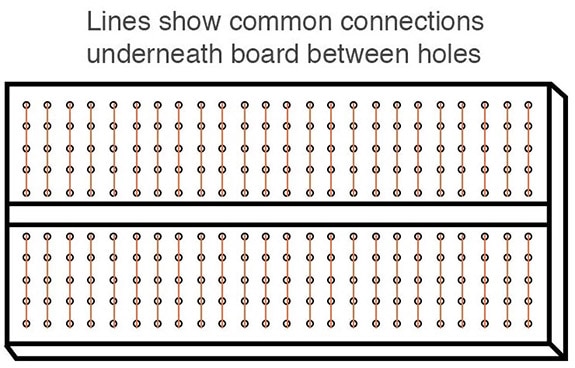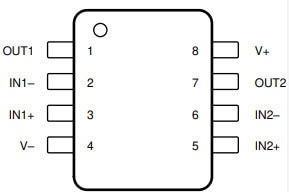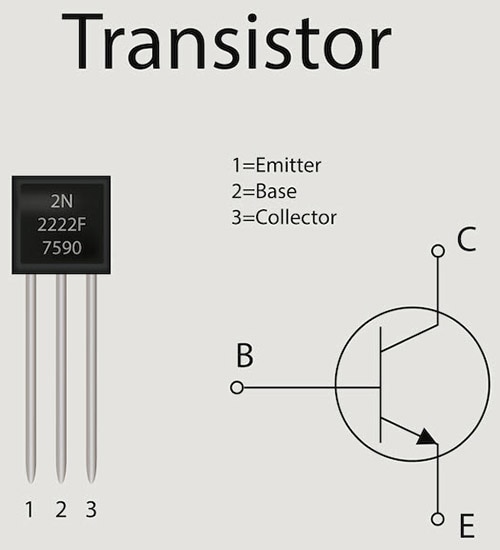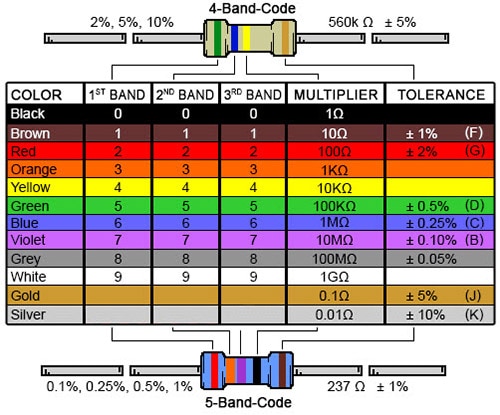制造商零件编号 FIT0096
BREADBRD TERM STRIP 3.20X2.00"
DFRobot
When starting maker projects, it may be daunting to understand and work with all the different electronic components. This guide provides a brief overview of common components, highlights their features and inner workings, and gives examples of use cases.
A breadboard is a prototyping tool consisting of interconnected nodes organized in rows and columns. These nodes are connected in line as shown below, meaning each hole along that row draws from the same voltage and current. Breadboards are solderless allowing for rapid experimentation while mimicking the layout and structure of circuitry found on printed circuit boards (PCBs) and in circuit schematics.

Breadboarding wires, or jumper wires, serve as conductive connectors between components on a breadboard. Linking nodes and components together using wires allows for logic to be formed. It is important to note that breadboarding wires can quickly derail into a mess of wires strewn across the breadboard if one is not careful during construction–ensure that wires are as flush as possible to the breadboard for ease of understanding.
Op-amps are core to any analog control logic and are the building blocks of almost all logic and advanced control. With uses in voltage amplification, current-to-voltage conversion, signal processing, and more, they output different voltages based on a comparison of the input voltages at the positive and negative terminals. Op-amps are extremely common in circuit schematics, and understanding their use cases is one of the best ways to learn how they operate.
In the context of breadboarding, two op-amps are often packed onto one component. Thus, reading the pinout of the particular component is crucial. Seen below is the pinout found in the datasheet of the linked component linked at the bottom.

Transistors are semiconductor devices that handle control logic and can operate as switches, gates, or amplifiers, depending on the functionality. They are core to all electronics, and their growth was famously projected by Gordon Moore in accordance with Moore’s Law theorized in 1975. It stated that the number of transistors in an integrated circuit would double every two years.
Transistors have three terminals: a base, collector, and emitter. Depending on the kind of transistor, the current coming into the base will allow or disallow current to flow from the collector terminal to the emitter.

Resistors, ubiquitous in circuitry, impede current flow in accordance with Ohm’s Law, V=IR. It is important to note how many Ohms of impedance the resistor generates, as this directly impacts how much current flows through the current. The stronger the resistor, the less current will be on the other side of the resistor. Weak resistors can also be overloaded and catch fire, so mind the current and ensure that you are safe while building circuits.
The bands on resistors denote the strength, and the diagram below shows how they can be calculated. This resistor color calculator (courtesy of DigiKey) is extremely useful in determining the strength of your resistor.

Capacitors act as voltage buffers, accumulating voltage over time to ensure that the voltage delivered to a component is smooth. These components are crucial in creating predictable, regular behavior in components.
Capacitors are rated for different capacitances that determine how much voltage a capacitor can accumulate.
Power supplies come in many forms, from a simple battery to a regulated power supply with variable voltage and current. It is important to consider what kind of power supply is needed for your application and to use safe voltages and currents so as to not overload your circuits, damage components, or cause harm to you.
Multimeters are a core component of any maker’s kit as they allow one to debug circuits by checking voltages, currents, and continuities across a node. Oftentimes, the expected and desired behavior of a circuit may not come to fruition due to building errors or a misunderstanding of the components. In these cases, multimeters allow us to get a better picture of what is happening at each section of the circuit and fix it to yield the intended result.
Whether you're an enthusiast or an experienced practitioner, diving deep into these components on a breadboard provides a hands-on, technical approach to designing innovative electronic projects. I encourage you to explore maker.io to see the variety of fun, insightful projects that can be built using these components!